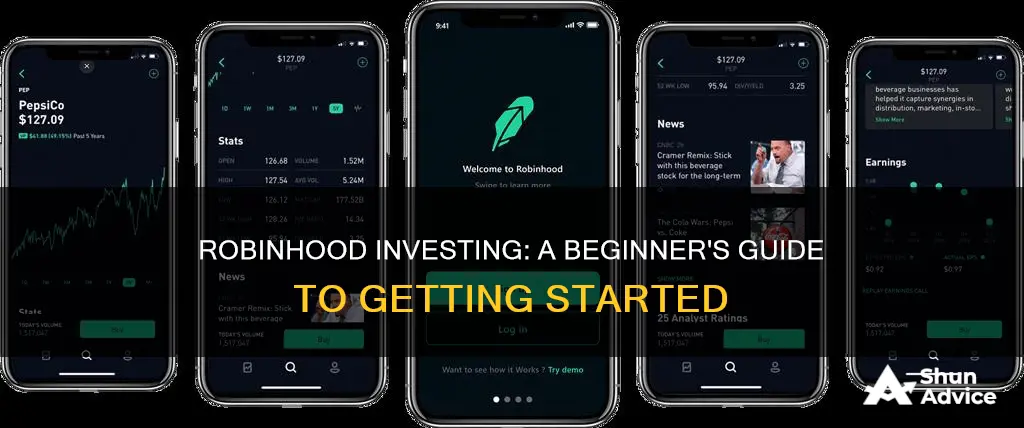
Investing through the Robinhood app is a popular way to get started with investing, especially for younger people. Robinhood is a commission-free trading platform, meaning users can invest in everything from stocks to exchange-traded funds (ETFs) and cryptocurrencies without going through a traditional brokerage. However, it has received criticism for making investing seem like a game and has faced regulatory penalties for misleading users and allowing customers to trade options when it was not appropriate. Before investing through Robinhood, it is important to do your research and understand the risks involved. If you are new to investing, it is recommended to start with a small amount of money and stick to stocks and ETFs. You can also use a stock market simulator to create a practice portfolio before investing your own money.
| Characteristics | Values |
|---|---|
| Account opening requirements | Age 18 or older, valid Social Security number, and a U.S. address |
| Investment options | Stocks, bonds, ETFs, crypto, and more |
| Commission charges | $0 commission charge on stocks & ETFs |
| Minimum investment | Start investing with as little as $1 |
| Investment tools | Stock market simulator, news sites, and content from verified financial planners |
| Trading hours | 9:30 AM-4 PM ET (regular market hours) and 7-9:30 AM and 4-8 PM ET (extended hours) |
| Order types | Market orders, limit orders, buy orders, and sell orders |
| Additional features | 24-hour market, dividend reinvestment, recurring investments, and bank transfers |
What You'll Learn

Understanding the basics of investing with stocks
Investing in the stock market is a great way to build wealth over time. Here are some key things to know about investing with stocks using the Robinhood app:
A stock is a unit of ownership in a company. If you own a stock, you become a shareholder, and you may be eligible to receive dividends if the company performs well and decides to distribute profits. As a shareholder, you may also have voting rights in some company decisions.
The stock market is a platform that connects buyers and sellers of stocks, allowing them to trade under agreed-upon rules. It provides an opportunity for individuals to invest in companies and potentially benefit from their success.
How to Get Started with Robinhood:
To start investing with Robinhood, you need to be 18 years or older with a valid Social Security number and a U.S. address. You can download the app, create an account, and link your bank account to fund your investments.
When investing through Robinhood, it is recommended to start with a small amount of money that you are comfortable losing. Focus on stocks and exchange-traded funds (ETFs) to begin with.
Creating a Diversified Portfolio:
Diversification is an important concept in investing. It involves spreading your investments across different assets to reduce risk. Aim to create a portfolio with at least 15 stocks from various industries and company sizes. Fractional shares offered by Robinhood allow you to invest in a diverse range of stocks with a small amount of money.
Understanding Order Types:
When buying stocks on Robinhood, you can place market orders or limit orders. During regular market hours (9:30 AM-4 PM ET), dollar-based buy orders are market orders, while share-based buy orders are limit orders with a preset price. Outside regular market hours, both dollar-based and share-based buy orders are placed as limit orders.
Analyzing Stocks:
Before investing in a stock, it's crucial to research and analyze it thoroughly. Visit the stock's detail page on Robinhood to review its historical performance, analyst ratings, company earnings, and other relevant information. This will help you make informed investment decisions.
Setting Investing Goals:
It's important to set clear investing goals. Determine your financial objectives, such as saving for a large purchase, a trip, or a down payment on a home. Calculate the cost of your goal, the time horizon, and how much you need to invest regularly to achieve it.
In conclusion, investing with stocks on Robinhood requires a solid understanding of the basics of the stock market, creating a diversified portfolio, analyzing stocks, and setting realistic investing goals. Remember that investing carries risks, and it's essential to do your own research and make decisions that align with your financial goals and risk tolerance.
Target's Overseas Strategy: Direct Investment Approach?
You may want to see also

How to buy stocks
To buy stocks on Robinhood, you'll first need to open a brokerage account. You can use a Robinhood brokerage account to buy Robinhood company stock, or you can use one of its competitors. Look for online brokers with good customer service, wide investment selections, low or no fees, and no commissions on stock trades.
Once you've chosen a broker, you'll need to add money to your account. You can then search for the stock you want to buy within your brokerage account platform. If you're buying Robinhood stock, for example, you can search for it using the ticker "HOOD."
When you've found the stock you want to buy, you'll need to decide how much you want to purchase. You can enter the number of shares or the dollar amount you want to buy. The availability of order types depends on the trading session and the eligibility of the stock. During regular market hours (9:30 AM-4 PM ET), dollar-based buy orders are entered as market orders, and share-based buy orders are entered as limit orders with a preset limit price. During extended hours (7-9:30 AM and 4-8 PM ET), both dollar-based and share-based buy orders are entered as limit orders with a preset limit price.
Before submitting your order, be sure to review the details and confirm that everything is correct. If you need to make any changes, select "Edit." If all looks good, you can then submit your order.
Keep in mind that trading outside of market hours comes with additional risks, such as increased price volatility and lower trading volume.
Cashing Out Putnam Investments: A Step-by-Step Guide
You may want to see also

How to diversify your portfolio
Diversifying your portfolio is a crucial step in reaching your long-term investment goals. Here are some detailed tips on how to diversify your portfolio:
Spread the Wealth
Diversification is a crucial concept in investing, often likened to the age-old adage of not putting all your eggs in one basket. The central idea is to spread your investments across different asset classes and markets to reduce risk. Equities, for instance, offer the potential for high returns, but it is unwise to put all your money in one stock or sector. Instead, consider investing in a handful of companies you know and trust and even use in your daily life.
Diversify Across Asset Classes
When diversifying your portfolio, it is essential to allocate your investments across various asset classes, such as stocks, bonds, cash, real estate, and alternative investments. Stocks can be volatile, offering high returns one year and steep losses the next. Bonds, on the other hand, are generally considered safer but yield lower returns. Cash and cash equivalents, like savings accounts, are considered the safest but tend to yield low returns.
Diversify Within Asset Classes
Diversification is not just about spreading your investments across asset classes but also about diversifying within each class. For example, instead of investing all your money in the stock of a single company, spread your investments across different companies and industries. This approach helps protect you from significant losses if a particular company or industry experiences a downturn.
Consider Index and Bond Funds
Index funds and fixed-income funds are excellent additions to your portfolio. These funds track various indexes and try to match the performance of broad indexes like the bond market. By investing in these funds, you are hedging your portfolio against market volatility and uncertainty. Index funds often have the added benefit of low fees, putting more money back in your pocket.
Diversify Geographically
Don't limit yourself to your home base; think globally. Investing in international markets and companies from different countries can further spread your risk and potentially lead to bigger rewards.
Know Your Risk Tolerance and Time Horizon
Understanding your risk tolerance and time horizon is crucial when diversifying your portfolio. If you have a long time horizon until retirement, you may have a higher risk tolerance and can invest in more volatile assets like stocks and real estate. If you are more risk-averse or have a shorter time horizon, you may prefer a portfolio with more stable and predictable returns, such as bonds or dividend-paying stocks.
Regularly Review and Rebalance Your Portfolio
Investing is a dynamic process, and your portfolio will require regular reviews and rebalancing to ensure it aligns with your investment goals. Over time, the percentage of your portfolio allocated to different asset classes will shift. For example, if stocks have performed well, they may now make up 70% of your portfolio instead of your desired 50%. Rebalancing involves moving some of those stock returns to other asset classes to get back to your target allocation.
Diversification Strategies
There are various strategies you can employ to diversify your portfolio, such as investing in exchange-traded funds (ETFs), mutual funds, or hiring a financial advisor. ETFs are like any other stock but are often favoured for their low costs, diversification benefits, and tax advantages. Mutual funds and financial advisors can help you select a variety of investments to meet your diversification goals, though they usually come with management fees.
Be Mindful of Over-Diversification
While diversification is essential, it is possible to over-diversify your portfolio. Over-diversification occurs when adding a new investment increases the overall risk and lowers the expected return without reducing risk. This tends to happen when there are already a large number of securities in a portfolio or if closely correlated securities are added.
In conclusion, diversifying your portfolio is a critical step in managing your investment risk and optimising your returns. By spreading your investments across different asset classes, markets, and companies, you can reduce the impact of losses and smooth out returns. Remember to regularly review and rebalance your portfolio to ensure it aligns with your investment goals and risk tolerance.
Investing vs. Saving: Where Should Your Cash Go?
You may want to see also

How to start investing with Robinhood
Investing through Robinhood is a simple process, but it's important to do your research and understand the risks before you begin. Here's a step-by-step guide on how to start investing with Robinhood:
Step 1: Understand the Basics of Investing
Before you start investing, it's important to understand what investing entails. Investing is the act of buying an asset with the expectation of generating future income or profit. In the case of Robinhood, you'll primarily be investing in stocks, which are units of ownership in a company. When you own a stock, you become a shareholder, and may be eligible for dividends and voting rights.
Step 2: Define Your Investment Goals
Before diving into the world of investing, take some time to reflect on your financial goals. Ask yourself where you are now and where you want to be in the future. Consider paying off any high-interest debt and creating an emergency fund before investing. It's also important to spend less than you earn and save or invest the difference.
Step 3: Research and Choose Your Investments
Robinhood offers a variety of investment options, including stocks, bonds, exchange-traded funds (ETFs), and cryptocurrencies. When choosing what to invest in, consider creating a diversified portfolio with at least fifteen stocks across different industries and company sizes. You can also invest in fractional shares, which allow you to start investing with just a few dollars.
Step 4: Open a Robinhood Account
To start investing with Robinhood, you'll need to open an account. Make sure you meet the requirements, which include being 18 years or older, having a valid Social Security number, and a U.S. address. You'll also need to download the Robinhood app or access their website.
Step 5: Fund Your Account and Start Investing
Once your account is set up, you can transfer funds from your bank to your Robinhood account. You can then start searching for stocks or other investments to purchase. When you're ready to buy, go to the stock's detail page to review historical performance, analyst ratings, and other relevant information. Select "Trade → Buy" or simply "Buy" if you don't currently own the stock. Review your order, confirm the details, and submit your order.
Remember, investing carries risks, and it's important to do your own research and consult with a financial professional before making any investment decisions.
Understanding Investment Revenue in the Cash Flow Statement
You may want to see also

How to use Robinhood the right way
Before you start investing using the Robinhood app, it's important to do your research and understand the potential risks involved. Here are some tips on how to use Robinhood the right way:
- Understand your motivation: Ask yourself why you want to invest. Are you looking for quick gains or are you interested in long-term financial planning? Knowing your motivation will help you stay focused and ignore impulsive decisions.
- Set clear goals: Determine your investment goals and create a plan to achieve them. Consider factors such as the cost of your goal, the time horizon, and how much you can invest regularly.
- Start with small amounts: If you're new to investing, it's advisable to start with a small amount of money that you're comfortable losing. This will help you get familiar with the platform and the market without taking on too much risk.
- Diversify your portfolio: Invest in at least 15 stocks across different industries and company sizes. This diversification can help reduce the impact of losses and lower the overall risk of your investments.
- Do your due diligence: Research the stocks you're interested in and understand their historical performance, analyst ratings, company earnings, and other relevant information. Make sure you understand what you're buying and selling.
- Use resources and simulators: Familiarize yourself with investing news sites, content from verified financial planners, and stock market simulators. These resources will help you make more informed decisions and develop healthy investing habits.
- Understand the basics: Learn about different investment concepts such as stocks, funds, ETFs, bonds, and dividend reinvestment. Educate yourself on financial jargon to make more confident decisions.
- Manage risk: Be cautious when investing in risky financial products. While Robinhood allows anyone with a bank account to buy and sell, it's important to assess your risk tolerance and make informed decisions.
- Pay off debts: If you're approaching investing from a financial planning perspective, ensure you've paid off credit card and high-rate consumer debt. Also, contribute to your employer-sponsored plan to maximize any potential match benefits.
- Consider long-term strategies: Instead of focusing solely on individual stocks, secure your financial future with diversified securities through your employer's plan or an IRA.
Remember, investing carries inherent risks, and it's important to do your own research and consult with financial professionals before making any investment decisions.
Cash Flow Notes: A Smart Investment Strategy
You may want to see also
Frequently asked questions
You need to be 18 years or older, with a valid Social Security number and a U.S. address. You can download the app, enter your bank details, and start investing. It's recommended that you start with a small amount of money and stick to stocks and ETFs.
Robinhood has categories of stocks like industrials, consumer products, and financials. You can start with the list of the 100 most popular stocks. You can also check the high and low of the past 52 weeks to know if you are buying at the peak or the dip.
Go to the stock's detail page, select Trade → Buy or just Buy. Enter the number of shares or the dollar amount you want to purchase, review your order, and submit it.
Before investing, figure out your motivation and set some goals. Do your research and create a diversified portfolio with at least 15 stocks across different industries and company sizes. Get familiar with investing news sites and content from verified financial planners.







